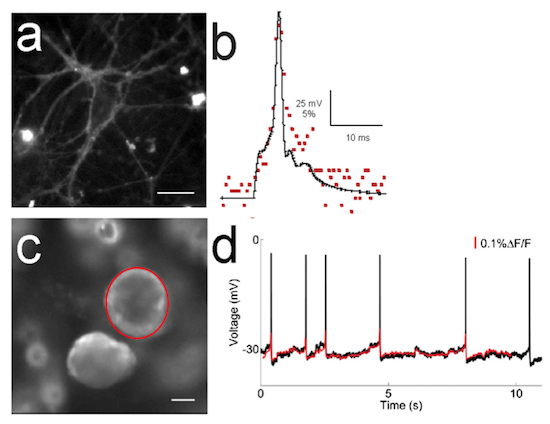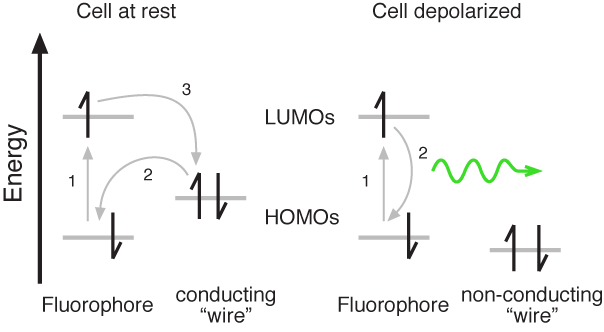Tsien’s VoltageFluors

Roger Tsien’s lab recently published the new generation voltage sensitive dye they were presenting at SfN: VoltageFluors. As often when then Tsien Lab takes on a new field, they start by taking a completely new approach. Instead of designing an indicator based on the previously used voltage detection mechanisms – Stark shift for electrochromic dyes or FRET for hybrid voltage sensors – they use a mechanism found in most commonly used calcium indicator dyes, such as Fluo-4 and OGB-1: photo-induced electron transfer (PET).

In PET an excited fluorophore (e.g. Fluorescein in Calcium Green) is quenched by transfer of an electron from a donor group (e.g. BAPTA in Calcium Green). In calcium indicators, this quenching is only possible if the “ionophore” (BAPTA) has not bound a calcium ion. Binding of calcium shifts the electronic energy levels, making PET unfavorable, ultimately leading to increase in fluorescence. In place of BAPTA, VoltageFluors use an electron rich group connected to the fluorophore via a “molecular wire”. Once the fluorophore is excited, an electron is transfered via the “wire” to the fluorophore, quenching the fluorescence. But (and this is the important part), the electron can only be transfered along a correctly oriented voltage gradient: if the electron donor is in a more negative environment than the fluoropore, electrons can “flow” along the “wire”, quenching via PET occurs, the fluorophore emits dimly. If the voltage gradient is inverted, PET becomes unfavorable leading to an unquenching of the fluorophore, the dye emits brightly.
The advantage of using PET is that the signal to noise ratio is much higher than for both electrochromic dyes and hybrid sensors. Also in VoltageFluors capacitive loading (a big problem with hybrid sensors) doesn’t occur. A further advantage is that VoltageFluors don’t appear to be (photo)toxic, a big problem that has made the use of voltage sensitive dyes difficult in many situations.
No doubt, VoltageFluors are a first generation indicator with lots of room for improvement — this is of course both a strength and a weakness. I for one can’t wait for them to become commercially available.
Post by Christian Wilms. Second figure is also by CW.
Does anyone know of a recent publication reviewing the latest developments of VF and other voltage sensitive dyes? And do current sCMOS cameras have the required characteristics to reliably record fast (1ms) events in neurons?